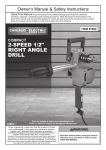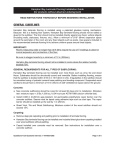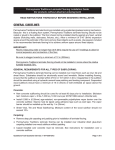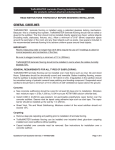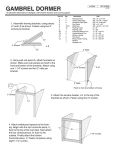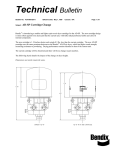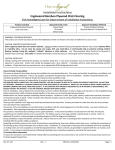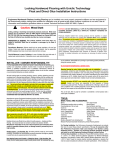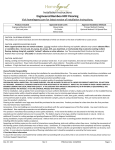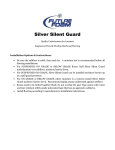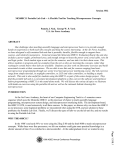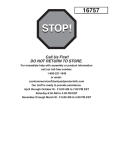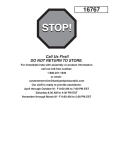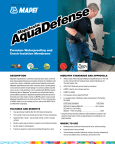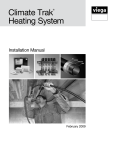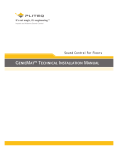Download Shaw HD80100240 Installation Guide
Transcript
R E V . 1 1 - 8 - 1 0 ARRAY RESILIENT INSTALLATION GUIDE Note: This Guide supercedes all printed technical materials produced for Shaw. R E V . 1 1 - 8 - 1 0 INSTALLATION GUIDE TABLE OF CONTENTS PAGES Installation, Subfloor & Underlayment Requirements Subfloor Preparations 2-6 Installation Instructions Tile 7 Instructions for Array-Grout 8 Installation Instructions Plank 9 Appendix Trouble Shooting Tips 12-14 1 R E V . 1 1 - 8 - 1 0 INSTALLATION, SUBFLOOR AND UNDERLAYMENT REQUIREMENTS Approved subfloors: a. b. c. Concrete: The concrete must be free of any curing compounds or adhesives. Even after old glued down carpet has been removed, and the subfloor has been scraped, it should NOT be assumed that the concrete is porous. Often the old adhesive has sealed the floor. A porosity test, using water, should be taken. Be aware that porous subfloors may take a different adhesive than non-porous subfloors. See adhesive instructions. If oil, grease, or other contaminants have deeply penetrated the concrete, and cannot be thoroughly removed, Shaw cannot be installed. If latex liquid has been used to seal off old cutback adhesives, the concrete has become non-porous. Lightweight concretes: Concretes in the lower end of this range are generally used for thermal and sound insulation fills for roofs, walls, and floors. The higher densities are used in castin-place walls, floors, roofs, and for pre-cast elements. The minimum density of the concrete should be greater than 90 lbs per cubic foot. The minimum compressive strength should be 3,500 psi or greater. Gypsum-based concretes are not recommended. If installing over gypsum or other forms of light concrete always apply an Acrylic based Primer-Sealer coat before toweling adhesive. Wood subfloors: Should be standard double layer construction, with a finished thickness of at least 1” and should have 18” of well ventilated air space underneath. Crawl spaces should be insulated and protected by a vapor barrier. Do not install vinyl flooring over a sleeper type subfloor, or over plywood that is directly over a concrete slab. Approved underlayments: I. PLYWOOD: Use only American Plywood Association (APA) underlayment grade plywood – minimum ¼” thickness. Allow expansion spacing between plywood butt joints of 1/32” – 1/16”. When installing underlayment, stagger cross-joints 4’ on an 8’ panel (minimum 16”), lightly butt the panels, and set fasteners flush or slightly below the surface level of the underlayment. Fill underlayment seams, nail holes and any indentations with an approved Portland cement-type floor patch, allow recommended drying time, sand the patch smooth, vacuum or sweep and apply adhesive (all dust must be COMPLETELY removed to ensure a strong adhesive bond). Sand filled when patching material has cured. Manufacture-certified Poplar, Birch and Spruce plywood underlayment, with a fully sanded face and exterior glue can also be used. II. LAUAN PLYWOOD: When used as an underlayment, it should be Type 1 (exterior grade). The best grade is BB and the next is CC. No lesser grades are acceptable. There is a wide variety of quality and species classes as lauan. Some may present severe problems such as discoloration, indentation, loss of bond and delaminating when used as an underlayment. Note: Extremely porous underlayments such as lauan as well as any other extremely porous wood or particleboard will reduce the flash and working time of adhesives. It is best to use an Acrylic Based Primer-Sealer coat to these products. If a claim results where lauan underlayment has been used, a manufacturers certification of lauan grade must accompany the claim e. f. Non-approved substrates include, but are not limited to: Oriented strand board (OSB), particleboard, hardboard, treated plywood, strip wood floors, chipboard, waferboard, Masonite, knotty plywood, glass mesh tile boards, cementitious tile backer boards, fire-retardant or preservative-treated plywood, asphalt tile, rubber tile, self-stick tile. NOTE: Any appearance or performance-related problems related to the underlayment are the responsibility of the installer and/or underlayment manufacturer. Radiant Heat: Subfloors should have operated for at least 3 weeks prior to installation to drive out moisture and calibrate temperature settings. All radiant heat floors should be turned off 3 days prior to 2 R E V . 1 1 - 8 - 1 0 g. installation and remain off for at least 6 days after installation to allow the adhesive to fully cure. Maximum operating temperature should never exceed 85°F. Radiant heat components must be a minimum of ½” separated from adhesive and tile. Quarry tile, terrazzo, and ceramic tile: Properly cleanse substrate using a commercial degreasing/dewaxing solution. Grind any highly polished or irregular surfaces. Fill any low spots, holes, chips and seams that may telegraph through the new flooring. Material Handling and Storage: All Shaw Tiles must be stored in a warm, dry area. Do not expose to very hot or cold temperatures. It is required that you adapt materials to jobsite conditions a minimum of 24 to 48 hours before scheduled installation. Shaw Tile must be stored laying flat and cartons never on edge. Check to make sure color and lot numbers are the same on jobs requiring more than one box on tile. Mix tile from several different cartons to blend minor shade variations. Temperature: Flooring and subfloor room temperature should be between 65° and 85 ° Fahrenheit. Maintain proper temperature for 48 hours before and after installation. After that, maintain a minimum 55-degree temperature. The building’s heating and air-conditioning system should be turned on at least one week before installation. Failure to follow these guidelines may result in an installation failure (i.e. flooring may expand or contract resulting in gapping). Moisture: Never install Shaw vinyl wherever surface or subfloor moisture is present. Excessive moisture will cause failure. New concrete slabs must cure for a minimum of 90 days. Even existing concrete slabs can have moisture problems. To be sure, conduct a moisture test several days before installation. The installer is responsible for moisture testing. See adhesive buckets for details. MOISTURE GUIDELINES FOR THE FLOOR COVERING INDUSTRY available from the World Floor Covering Association, at 1-800-624-6880. PH Levels: Moisture can directly affect the cure, set and bond of adhesives. On well-cured adhesives, the presence of pH values has proven to be the most significant factor in adhesive failures. It is vital that moisture be present for pH to be a factor. High pH levels are due to cement, type of aggregate, cement ratio of concrete and how well cured the concrete surface is. On new or existing concrete a pH test should be taken. A pH level above 9 is unacceptable, and the floor should not be installed. Porosity: A non-porous substrate is one which does not absorb water. If you are not sure whether a floor is porous or non-porous, sprinkle some water on the floor over several different areas. If the water beads up, then it’s a non-porous floor. If it soaks in, it’s a porous floor. Use a small amount of water for the test, and allow floor to completely dry before continuing. If a bare concrete floor is not porous, a sealer or curing compound may have been used. Such treatments should be removed before installing a new floor or underlayment, and the floor re-tested for porosity at that time. HVAC: Air conditioning is recommended whenever possible and at comfortable levels as moisture is removed constantly and this will provide for a drier atmosphere that affects the adhesion to the subfloor favorably. However in hot and humid climates the air conditioning can cause condensation in the floors so that the subfloor must have a moisture barrier beneath the slab or in the crawl space. 3 R E V . 1 1 - 8 - 1 0 SUBFLOOR PREPARATION In general, all substrates must be free of contaminants such as dirt, weak concrete, grease, wax, oil, sealers, paints, curing compounds, and old adhesives. The surface should be leveled to within 1/8 inch in ten feet; and all constructions seams, expansion joints, and holes should be filled level with the surrounding surface to eliminate telegraphing of such irregularities. Removing Old Adhesives: Old asphaltic “cut-back” adhesives can destroy new adhesive and stain Shaw vinyl. These must be completely removed, encapsulated or covered with plywood underlayment. Be sure to remove adhesive in dips, joints, etc. Some previously manufactured cut-back adhesives contained asbestos fibers, which are not readily identifiable. Do not use power removal devices, which can create dust. The use of solvent-based adhesive removers is not recommended. NOTE: If d-limonene (citrus-based) cleaners/removers are used (Orange All), subfloor must be thoroughly rinsed. If complete removal of old adhesives or covering them with plywood is not possible, the use of a Portland Based Leveling or Patching Compound is acceptable. Please follow manufacturer’s instructions carefully. For “Recommended Work Practices for the Removal of Resilient Floor Coverings” write to the Resilient Floor Covering Institute, 966 Hungerford Dr., Suite 12-B, Rockville, MD 20850. Patching & Leveling: Use only Portland-cement based patching and leveling compounds. Self-leveling underlayments can have very high moisture content and require longer curing time: up to 10 days. Check with a moisture meter before starting installation. Note: Adding latex to levelers will normally make the floors NON-POROUS. Test for porosity and use the non-porous adhesive instructions if necessary. Follow the manufacturer’s instructions. Do not over-water underlayments! Sand underlayment smooth after it is cured. The installer is responsible for cure times, moisture content, adhesive bonding and the structural integrity of any leveling or patch compound used. Embossing Levelers: Embossing levelers are for sheet goods with textures that could telegraph through Shaw products and be visible on the surface. Note: The use of levelers on sheet goods will not create a porous subfloor. Concrete Slabs: NOTE: All concrete (new and old) must be tested • The installer is responsible for moisture testing. See adhesive buckets for details. • New concrete should cure with good ventilation at room temperatures for no less than 90 days and must be tested for moisture and pH prior to installation. • Do not install where moisture, hydrostatic pressure, or alkaline conditions are evident. (See below) • Concrete must be clean, dry, smooth, and structurally sound and free of paint varnish, adhesive, oil, grease, solvents and other extraneous material including curing and parting compounds, sealers and surface hardeners that will inhibit bonding. • Lightweight concrete should be avoided because of its inherent weakness • Whenever possible grind a concrete subfloor to tolerance rather than fill. Installation failures due to the above issues are not the responsibility of Shaw and warranties will not apply. Whenever questionable surfaces are involved, Shaw recommends a bond test as described later in this section. Properly prepare substrate by grinding or sanding. All dust must be COMPLETELY removed to ensure a strong adhesive bond. Surface irregularities will telegraph through the tile. Allow at least 24 hours for underlayment drying before installing Shaw flooring. If self-leveling underlayments are used they must fully cure before installing Shaw floor tiles. Test self-leveling compound for moisture before installing. The installer is fully responsible for moisture and leveler related problems. 4 R E V . 1 1 - 8 - 1 0 Sealers: Shaw does not endorse any concrete or floor sealers against moisture. IF MOISTURE IS PRESENT, DO NOT INSTALL FLOOR. Some sealers will protect the installation against alkalinity. Some also serve as a barrier between old and new adhesives to deaden old adhesive tack, prevent plasticizer migration and seal over dust or old cutback adhesives. Most latex- and acrylic-based sealers are compatible with Shaw adhesives. Apply sealers to the floor according to the manufacturer’s instructions. Be sure to apply the product evenly across the entire surface of the floor. There must be no gaps in the installation. Allow sealer to dry completely before applying adhesive. NOTE: Shaw warranties its Tile and Adhesives to be free of defects. The condition of a subfloor, which causes adhesion problems due to not recommended, improper, incorrectly prepared sealers, embossing leavers, patches, concrete, gypsum based products ect, becomes the sole responsibility of the installer and/or manufacturer of the particular subflooring product. Existing Resilient Floors: When installing Shaw floor tile where there is an existing resilient floor, it may be best to remove the present floor and prepare the structural floor for a fresh application of the Shaw. If existing resilient tile and sheet vinyl floors are in good condition and thoroughly bonded to the structural floor, it may be possible to install. The exception is that any tile or sheet that is a cushion construction must be removed. Note: A layer of resilient or soft underlayments like lauan may compromise the inherent strength of Shaw Tiles and Planks to resist indentations. Do not install over more than one layer of existing flooring. Note: The use of levelers on non-porous subfloors will not create a porous subfloor. Existing tile or sheet resilient floor must be stripped using Shaw approved stripper to remove wax or other contamination and rinsed with clear water and allowed to dry. This is also the case when new sheet vinyl is used. Very smooth or high-gloss floors need to be lightly abraded to rough up the surface to allow proper adhesive bonding. In some areas it has become common to use underlayment. Call Shaw Technical Support for special requirements for such products. Quarry Tile, Terrazzo, Ceramic Tile: Properly cleanse substrate using a commercial degreasing/dewaxing solution. Grind any highly polished or irregular surfaces. Fill any low spots, holes, chips and seams that may telegraph through the new flooring. Test for porosity and use the appropriate adhesive application method. Bond tests are required. Moisture and PH Testing: A moisture test should be done several days before installation. The installer is responsible for moisture testing. Shaw recommends all concrete subfloors (new and old) be tested using Calcium Chloride Test ASTM F1869.Unacceptable results using this method would be over 5 lbs for 24 hours per 1000 square feet. Electronic meter testing is not considered a replacement for a Calcium Chloride Test; the following moisture readings are just an indication that a Calcium Chloride test should be performed. Concrete subfloors must have moisture barriers installed under the slab and be determined, through testing, to be dry and not subject to water absorption. For more information about moisture problems and moisture testing, refer to MOISTURE GUIDELINES FOR THE FLOOR COVERING INDUSTRY available from the World Floor Covering Association, at 1-800624-6880. . 5 R E V . 1 1 - 8 - 1 0 Bond Test: To determine if a subfloor is compatible to Shaw adhesives, or to determine if the porous or non-porous adhesive application method is required, use this test: Using the flooring and adhesive suitable for the subfloor, install a 2’x2’ section following the recommended installation procedures Select areas next to walls, columns, or other light traffic areas. Tape the perimeter with duct tape to prevent edge drying of the adhesive. After 48 hours, the adhesive should be dry and the flooring should be difficult to remove. Note: the adhesive is dry at this point – but not cured. Full cure and maximum bond does not occur for 68 days. On large installations, tests should be taken every 50 feet. Bond testing may take some time to complete, but the cost and time involved in a floor failure are considerably more. General: For best results, the room temperature in the area of installation must be 65-85° F for 48 hours before, during, and after installation. Flooring must be acclimated in the room they are to be installed in for a minimum of 24 to 48 hours prior to installation. Be sure to use Shaw tiles of the same color lot for best color matching. Mix tile from several different cartons to blend minor shade variations. If the Shaw Tile or Plank has directional arrows follow accordingly if not lay tile and planks keeping the embossing of the product flowing in the same direction. Note: All Warranties and guarantees regarding the suitability and performance of any products, if not supplied by Shaw, rests with the material manufacturer or the installation contractor and Not with Shaw . IMPORTANT TIPS: • All Concretes (old or new) should be tested for possible moisture. • Underlayments should be APA underlayment grade. Use only Portland-Cement base patching and leveling compounds. • Room temperature should be between 65° and 85 ° Fahrenheit. Maintain proper temperature for 48 hours before and after installation. • Materials and Adhesive should be allowed to acclimate for a minimum of 24 to 48 hours. • Use only the appropriate Shaw Adhesive. • All installations must be rolled with a minimum 100 lb roller. If tiles and plank products are to be installed as a combination, it is imperative to make sure that these products are of the same gauge. 6 R E V . 1 1 - 8 - 1 0 INSTALLATION FOR TILE Layout of the Room for Squarely Laid Fields To square the area to be covered, first find the center of one end of the main rectangle. Locate the same point at the other end wall. Snap a chalk line between these points to mark the center line on the floor. Then measure along this center line to find the middle of the room. Fig. 1 At the center point, mark off a line across the room at exactly right angles to the first line. This may be accomplished by the 3-4-5- triangle method as shown in Figure 1. Then measure 4 feet toward each side wall from the center point. Then measure 3 feet from the center point along the longer line, measure exactly 5 feet from the 3 foot mark on the center line to the 4 foot mark on the crossline. If the 5 foot measurements do not come out exactly 5 feet, the center crossing lines are not at a true right angle. For large rooms, multiples of the above dimensions may be used to obtain greater accuracy. (6-8-10 or 9-1215, etc.) Dry-lay a row of tiles from the center line to the side wall to determine the space left for the borders. If the resulting border is too small, move the starting point over a half tile width so that it straddles the center line. Repeat the same procedure lengthwise of the room. (This can readily be figured out from the room dimensions without putting down the tiles if desired.) Fig. 2 If it is decided to have the center row of tiles straddle either or both of the center lines, additional guidelines should be snapped on the floor ½ tiles width on one side of either or both center lines as required. (See Figure 2) After the border widths have been determined and the center starting lines have been snapped spread the recommended adhesive on the center lines leaving portions of the lines at center and near each wall uncovered as shown in Figure 3. Fig. 3 Spread the adhesive over one-half the area and after it is ready, start laying tile from the right angle formed in the center of the room by center lines. Lay toward the two corners of the room as shown. Always refer to your guide lines as you progress with laying tile so that any mistake can be corrected before it is too late. Sometimes it’s necessary to compromise on the rightness of joints to make allowances for unevenness or waves of the subfloor. Take care to place tile as accurately as possible without sliding them into place. If grouting tile please leave appropriate spacer between tiles and follow instruction on page eight for use of Array-Grout. IMPORTANT: All flooring must by rolled with a minimum 100-lb roller after installation. Use a hand roller in areas not reached with a 100-lb. roller. 7 R E V . 1 1 - 8 - 1 0 Array-Grout □ Stain Resistance □ Premixed □ No Shading □ Resists mold and mildew Coverage: Joint Width 1/16 “ 1/8 “ 1/4 “ Coverage per gallon 500 sq. ft. 300 sq. ft. 140 sq. ft. Product Description: Array-Grout, with a unique formula, offers stain resistance color consistency and a smooth texture for easy spreading and clean-up. Uses: For Grouting Shaw Calcutta tiles. Can also be used on vitreous, semi-vitreous or absorptive tile including ceramic, mosaic, quarry, cement, porcelain, brick, mini-brick, precast terrazzo and natural stone. □ For grout joints up to ¼” □ Use on floors, countertops, walls and ceilings □ For interior installations Limitations: Shaw Array-Grout should not be installed, when ambient temperature is below 60° F and above 90° F. Shaw Array-Grout should be kept at room temperature for 24 hours before installation. Some types of glazed ceramic tile, marble and stone can be scratched, stained or damaged when grouted with pigmented or sanded grouts. Generally white grout is best suited for grouting white or light colored marble or granite. Follow tile manufacturer’s recommendations. Test a small area prior to use. Certain tile with high absorption, surface porosity or rough textured surfaces and certain types of porcelain may require sealing prior to grouting to prevent staining. Surface Preparation: Tile must be firmly attached to a sound substrate and setting material must be cured for a minimum of 24-48 hours before grouting. Remove all spacers. Grout joints should be uniform in depth and width and free of all loose debris, contaminants and excess mortar or adhesive. Application: New installation: Before grouting, soak the grout sponge in a pail of clean cool water and thoroughly wring out. Next, use the dampened sponge and lightly wipe the tile surface in an area no larger than 5-10 sq.ft. A slightly wet tile surface allows the grout to glide easily over the tile and into the grout joint while providing for easier cleanup. While tile is still damp, dispense a liberal amount of grout onto the tile surface. Using the grout float, press the grout into the grout joints over the dampened area apply grout on no more than 5-10 sq. ft. at a time to allow for prompt cleaning; delayed cleaning may cause some cracking. Next, place the grout float on edge at a 45° angle and rake the float diagonally across the tile surface while exerting a downward pressure. This will force the grout evenly into the grout joints. Immediately remove all excess grout from the tile surface by holding the grout flat at a 90 ° angle to the tile and drawing it diagonally across the tile. Finally, clean by soaking grout sponge in clean cool water. Wring out excess water completely. Use dampened sponge in a circular motion to smooth grout joints and clean off any remaining excess grout. Continued rinsing of sponge in clean, cool water will aid in cleanup. Avoid excess water in grout joints. For final cleaning/haze removal, allow grout to cure for 24 hours. Use a dampened sponge, then soft cloth to polish off residue. Repair existing grout: Remove existing old grout with a grout saw 1/8” below the surface of existing tile, Sweep or vacuum dust and debris from surface of tile and grout joints. Shaw Array-Grout can be applied directly over old grout. Apply enough to totally cover the old grout. Follow directions for new installation as shown above. Cleanup: Clean tools and hands with cold water before material dries. Care and Maintenance: Mold and Mildew can grow on dirt, food, and soap scum that can accumulate on the grout surface. Routine cleaning will limit mold and mildew growth. Safety: Avoid eye contact or prolonged contact with skin. Wash thoroughly after handling. If eye contact occurs, flush with water for 15 minutes and consult a physician. 8 R E V . 1 1 - 8 - 1 0 INSTALLATION FOR PLANK Layout of the Room: Find the center point of the room. Strike a line. Obtain a true 90’ angle by using a carpenter’s square. Strike a second line which will divide the room in to four equal parts. Measure the distance from the center to the wall, parallel to the direction of the plank. Divide the measurement by the width of the plank. If less than half remains as the border plank, adjust the point to compensate. This will give a larger border along the wall and reduce the chance of having to cut a small sliver of flooring to place along the wall. LAYOUT OF THE PLANK: Carefully place the first piece of plank at the junction of the chalk lines. Continue to lay the plank, making sure each plank flush against the chalk line and tight against the adjoining plank. Make sure the plank is well seated into the adhesive paying special attention, to the edges. Lay row by row, or in a pyramid fashion as shown below. FITTING THE BORDER: Measure the distance from the last plank in the row to the wall. Mark the plank and cut it against the mark. Lay the plank in place, making sure that the cut edge is against the wall. Fitting Around Irregular Objects: Make a pattern out of heavy paper to fit around pipes and other irregularities. Place the pattern on the plank, trace cutting along the trace lines. IMPORTANT: All flooring must by rolled with a minimum 100-lb roller after installation. Use a hand roller in areas not reached with a 100-lb. roller. 9 R E V . 1 1 - 8 - 1 0 TROUBLE SHOOTING TIPS Occasionally, problems can arise during installation or during the life of the floor. The following information has been compiled as a way to prevent failures from occurring. More than seventy-five (75) % of installation related failures are due to improper use of adhesives. Problem: 1. Tiles not adhering to subfloor with little to no adhesive transfer. 2. Tiles curling up or releasing at the edges. 3. Product is well bonded in some areas but not in others. 4. Trowel marks telegraphing through the tile. 5. Gapping between the tiles after installation. 6. Adhesives not drying or curing properly. 7. Adhesive becoming “wet” or “gummy” some time after installation. 8. Gaps between tiles which are corresponding with underlayment joints. 9. Tiles coming loose with adhesive dry and powdering. 10. Bumpy, dimpled or wavy surface of product. 11. Self-leveling underlayment. Problem: Tiles not adhering to subfloor with little to no adhesive transfer: Causes: • • • • • • Most of the time this problem will occur with wet-set adhesives. Allowing adhesive to set or skin over prior to laying tiles. Improper rolling or not rolling at all. Not monitoring the amount of open time allowed over very porous subfloors (some underlayments and levelers can cause this). Spreading more glue than can be covered with product in the allowed amount of time. Moisture content in subfloors. Problem: Tiles curling up or releasing at the edges of the product: Causes: • • • • Wrong trowel size used (too little adhesive) causing tile movement. Allowing a wet-set adhesive to over dry. Tiles not acclimated to job site causing expansion or contraction. Improper rolling or not rolled at all. 10 R E V . 1 1 - 8 - 1 0 Problem: Product is well bonded in some areas but not in others: Causes: • • • • • • • Since adhesives do not fail selectively, you must look elsewhere for the cause. Spreading more glue than can be covered with product in the allowed amount of time (this will occur mostly with wet-set adhesives). Improper rolling in areas or rolling too late. Some underlayment panels may absorb adhesive liquids faster than others. Areas most recently laid will bond well into fresh adhesive application. While initially laid areas will not bond as well in dried adhesive, even if rolled. Moisture present; Moisture can be present in only one part of a subfloor resulting in initial failure of adhesive to cure properly, or later problems related to hydrostatic pressure. Wrong or worn trowels, varying spread angles can cause inconsistent adhesive applications and often inadequate spread rates. Problem: Trowel marks telegraphing through the tile: Causes: • • Adhesive was allowed to dry or skin over prior to laying tiles. In many cases this will take place with wetset adhesive. Improper rolling, rolling too late or not rolling at all. Problem: Gapping between the tiles after installation: Causes: • • • Tiles were not acclimated to job site. Tiles were installed while warm and began contracting as they cooled and before adhesive was able to set up. Tile was installed at warm room temperature. Tiles began to contract as air conditioner comes on and adhesive was not allowed to set up properly. Installation was not properly rolled or not rolled at all. This will result in a poor bond between product and substrate. Problem: Adhesive not drying and curing properly: Causes: • • • • • Moisture present in subfloor Subfloor and/or ambient temperature too low Using a wet-set adhesive over a non-porous subfloor Old cutback or other adhesive residues from prior installations leaching through subfloor and breaking down adhesive. Contaminants on the subfloor (waxes, oils, solvents, etc.) attacking adhesive and breaking it down. 11 R E V . 1 1 - 8 - 1 0 Problem: Adhesive becoming “wet” or “gummy” some time after installation; Causes: • • Moisture present in subfloor Old cutback adhesive from prior installations or contaminants breaking down the adhesive. Problem: Gaps between tiles which are corresponding with underlayment joints. Causes: • Shrinkage or separation of the underlayment panels Problem: Tiles coming loose with adhesive dry and powdering: Causes: • High alkalinity in subfloor. This will usually take place within 3 to 6 weeks after installation. Problem: Bumpy, dimpled or wavy surface of product: Causes: • • Irregularities in the subfloor or underlayment telegraphing through the product. Often occurs with unapproved underlayment such as waferboard, OSB, particle board etc. Poorly prepared concrete subfloors will also cause this. All installations adhered will conform to any subfloor irregularities. Problem: Self leveling underlayment: Causes: • • • • Separating from itself (still stuck to tile and substrate). Poor quality product or bad mix of a good product or moisture problems. Separating from subfloor (still stuck to tile). Improper preparation of substrate surface, or moisture problems. Separating from tile (adhesive stuck to underlayment). Adhesive was allowed to dry. Denting from heels, rollers, chairs, etc. Density of underlayment too low, too little resistance to point loading. 12













